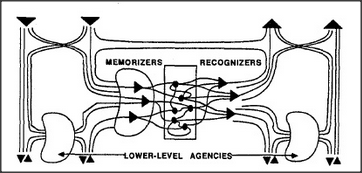


How do frames become activated? This amounts to asking how we recognize familiar situations or things. There is no limit to how complicated such a question can become, since there are no natural boundary lines between recognizing, remembering, and all the rest of how we think. For questions like this, with no place to start, we have to construct some boundary lines from our own imagination.
We'll simply assume that every frame is activated by some set of recognizers. We can regard a recognizer as a type of agent that, in a sense, is the opposite of a K-line — since instead of arousing a certain state of mind, it has to recognize when a certain state of mind occurs. Accordingly, the recognizers of a frame are very much like the terminals of a frame, except that the connections to the terminals are reversed.

This suggests that not only frames but agencies in general might be organized in the form of agents sandwiched between recognizers and memorizers.

This sketch of how our agencies are organized is oversimplified. Each agent, be it a frame, a K-line, or whatever, must have some machinery for learning when it should become active — and that may require more than simply recognizing the presence of certain features. For example, to recognize an object as a car, it isn't enough that it include some assortment of parts like body, wheels, and license plate; the frame must also recognize that those parts are in suitable relationships — that the wheels be properly attached to the body, for example. Workers in the field of Artificial Intelligence have experimented with a variety of ways to make frame-recognizers, but the field is still in its infancy. The recognizers of our higher-level agencies might have to include mechanisms as complex as difference-engines in order to match their relational descriptions to actual situations.